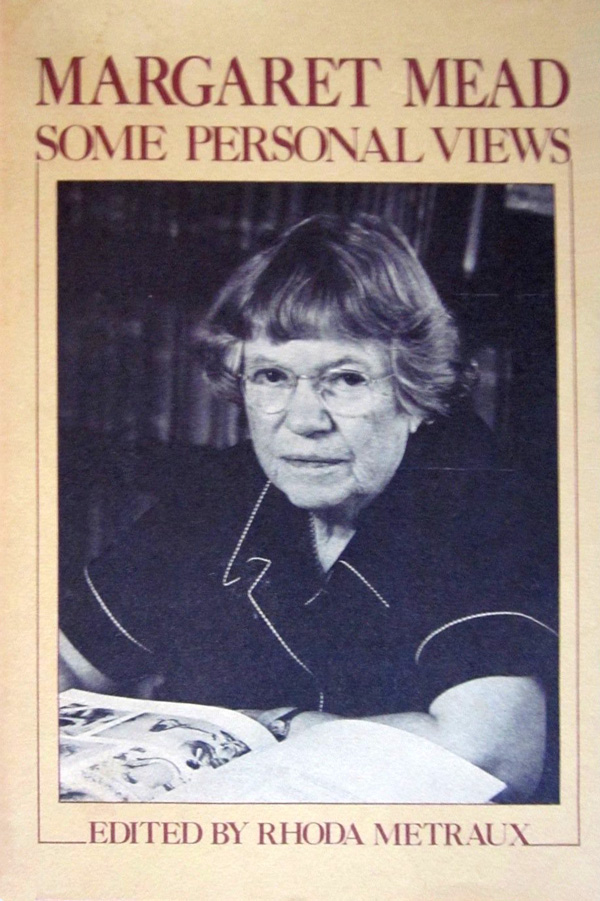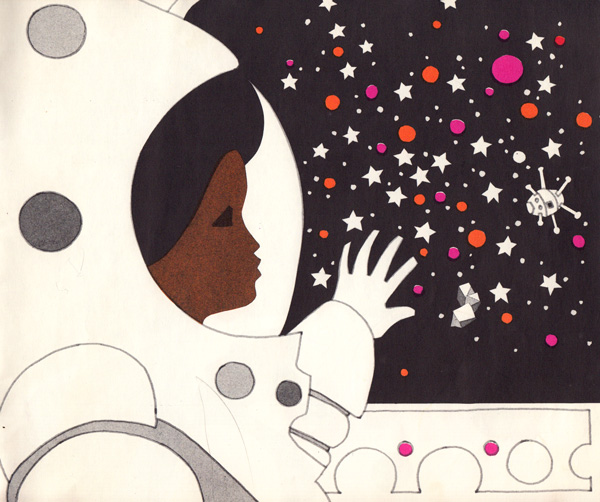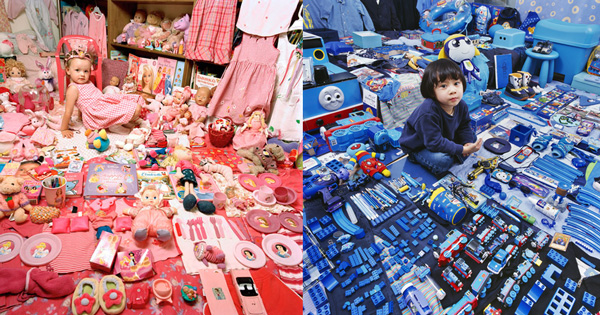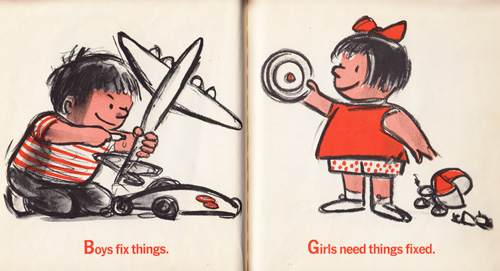Margaret Mead on Female vs. Male Creativity, the “Bossy” Problem, Equality in Parenting, and Why Women Make Better Scientists
by Maria Popova
“In the long run it is the complex interplay of different capacities, feminine and masculine, that protects the humanity of human beings.”
 Margaret Mead is celebrated as the world’s best-known and most influential cultural anthropologist, having not only popularized anthropology itself but also laid the foundation for the sexual revolution of the 1960s. She brought the essential tools of anthropology — the art of looking, coupled with a great capacity for listening, for asking and answering questions — to her prolific university lectures, public talks, and presentations at various organizations that claimed her time and thought. In the sixteen-year period between 1963 and January of 1979, Redbook Magazinepublished Mead’s answers to the best questions she had received from audience members over her extensive career — questions about love, sex, religion, politics, social dynamics, gender equality, personal choices, and the human condition.
Margaret Mead is celebrated as the world’s best-known and most influential cultural anthropologist, having not only popularized anthropology itself but also laid the foundation for the sexual revolution of the 1960s. She brought the essential tools of anthropology — the art of looking, coupled with a great capacity for listening, for asking and answering questions — to her prolific university lectures, public talks, and presentations at various organizations that claimed her time and thought. In the sixteen-year period between 1963 and January of 1979, Redbook Magazinepublished Mead’s answers to the best questions she had received from audience members over her extensive career — questions about love, sex, religion, politics, social dynamics, gender equality, personal choices, and the human condition.
After Mead’s death in late 1978, her partner for the last twenty-two years, the anthropologist and Redbook editor Rhoda Metraux, collected the best of these questions and answers in Margaret Mead: Some Personal Views (public library). As Metraux writes in the foreword, “Margaret Mead’s most winning gift was surely her capacity for immediate, zealous response… She took for granted that a sophisticated question required a sophisticated answer, but she never rebuffed the person who had to struggle to find words. One thing exasperated her: without hesitation she pricked the balloon of the pompous, pretentious questioner.”

With her characteristic blend of scientific rigor, humanistic wisdom, and strong personal conviction, Mead addresses a number of issues all the timelier today, but none with more prescience than the question of the shifting social norms and responsibilities for women and men.
In 1963, she offers a wonderfully dimensional answer to a question about why “the most outstanding creative people in all fields have been predominantly men,” folding into her rationale the still-radical assertion that women make naturally better scientists:
There are three possible positions one can take about male and female creativity. The first is that males are inherently more creative in all fields. The second is that if it were not for the greater appeal of creating and cherishing young human beings, females would be as creative as males. If this were the case, then if men were permitted the enjoyment women have always had in rearing young children, male creativity might be reduced also… The third possible position is that certain forms of creativity are more congenial to one sex than to the other and that the great creative acts will therefore come from only one sex in a given field.There is some reason to believe that males may always excel — by just the small degree that makes the difference between good capacity and great talent — in such fields as music and mathematics, where creativity involves imposing form rather than finding it. There is also reason to believe that women have a slightly greater potential in those fields in which it is necessary to listen and learn, to find forms in nature or in their own hearts rather than to make entirely new ones; these fields could include certain areas of literature, and some forms of science that depend on observation and recognition of pattern, such as the study of living creatures or children or societies.
But Mead argues that the capacity for achievement is, above all, a matter of context, which is invariably a social construct — something that only intensifies our responsibility in creating a cultural context that allows all creative abilities to shine:
When women work in a creative field, even one that is particularly congenial to them, they must generally work with forms that were created by men, or else struggle against special odds to develop new forms. Until we have an educational system that permits enough women to work within any field — music, mathematics, painting, literature, biology and so on — so that forms which are equally congenial to both sexes are developed, we shall not have a fair test of this third possibility.We do not know that what one sex has developed, members of the other sex can learn — from cookery to calculus. In those countries of the Eastern bloc in which women are expected to play an equal part with men in the sciences, great numbers of women have shown a previously unsuspected ability. We run a great risk of squandering half of our human gifts by arbitrarily denying any field to either sex or by penalizing women who try to use their gifts creatively.
In another question from December of the same year, Mead returns to the cultural differences across the Iron Curtain. A few months earlier, in June of 1963, Soviet cosmonaut Valentina Tereshkova had become the world’s first woman in space. It would be twenty years until the second, American astronautSally Ride, launched into the cosmos. Considering the cultural context Russian vs. American women have for achievement in space exploration, Mead writes:
On the question of woman cosmonauts, the Russians have been able to be realistic and practical. If we are going to do anything important with space, especially with space colonization, then we need to know at once how well women can withstand the new conditions. The American tendency to protect men’s sense of masculinity by keeping women out of things results — as does our handling of race — simply in an American loss.

Illustration from 'Blast-Off,' a visionary 1973 children's book celebrating gender equality and ethnic diversity in space exploration. Click image for more.
In November of 1965, Mead answers a question about women’s evolving identity outside “their purely feminine role” and how they are to seek fulfillment beyond the qualities of beauty and charm traditionally rewarded as the height of female accomplishment:
It is probable that far more women can achieve lasting contentment … where a woman can be honored as a person because she has borne and cared for children, has taught in a school or cared for the sick, has managed a business, has practiced a profession, has written poems.[...]When marriage was for life and when death was likely to come early, a woman’s career as wife and mother was often completely circumscribed by her husband’s career as provider and achiever.Today, however, this is no longer true. We educate girls so that they are capable of greater intellectual accomplishment than our form of marriage and housekeeping permits them to use. Marriages are not always for life. And child rearing takes up only part of a woman’s adult life. These three major changes have refocused our attention on the question of woman’s identity and the relationship between the feminine arts and feminine accomplishments.
But as these changes were afoot in the 1960s — the cusp of monumental cultural change, propelled by such landmark events as the 1963 publication of Betty Friedan’s The Feminine Mystique and the introduction of the oral contraceptive pill in the early 1960s — many bemoaned the “defeminization” of society. Mead handles this term with enormous semantic skepticism and addresses it in answering a question from March of 1966:
Defeminization [may] refer to role. Where men have been the traditional breadwinners, initially it seems defeminizing when women go out to earn their living. Where all secretaries were men, as at one time they were in the English-speaking world, it was defeminizing for a woman to take a position as a secretary. Most roles of this kind are a matter of convention in a particular society at a given time. Their specific definitions as “masculine” or “feminine” often have very little to do with the capacities of men and women.There is a sense, however, in which certain changes in women’s roles may be regarded as dehumanizing. Traditionally women have had to consider their children’s long-time protection and well-being to be their central goal. Where a society, by its moral conventions and standards of living or by various coercive rules and regulations,* forces women to neglect any of the necessary forms of prenatal and maternal behavior, there may be a dehumanizing effect on the members of that society — both men and women.

Before WWII, pink was a color associated with masculinity, considered a watered-down red symbolizing the power generally associated with that color. Photographs from Korean visual artist JeongMee Yoon's 'Pink and Blue Projects.' Click image for details.
Mead’s words ring with particular poignancy half a century later, in the Lean Inera and its crusade against “bossy”, as she considers how women can counter these claims of “defeminization,” rooted in old values and male ideals, by claiming a new context of evaluation:
Whenever women become part of an organization or an activity that is defined as aggressively and ruthlessly competitive, they must develop a style of behavior different from that of men in the same occupation if they are not to become “defeminized.” … In the conference room, women do better to insist on high standards of courtesy, comfort and consideration in a mixed group of which they are an integral part. In the long run it is the complex interplay of different capacities, feminine and masculine, that protects the humanity of human beings.
Mead’s prescience doesn’t end there — half a century before Shonda Rhimes addressed the issue in her superb commencement address, Mead considers the impossible standards for women as they try to reconcile inhabiting their capacities fully with fulfilling traditional roles. In June of 1967, upon being asked whether modern women are becoming “increasingly narcissistic,” Mead offers a brilliant answer at once thoughtful and feisty:
The ideal of the all-purpose wife is perhaps the most difficult any society has set for its women.[...]It is taken for granted that [a woman] ought to be able to do everything, however hard and tedious, and still give the impression that she spends her days pleasantly and restfully, that she has the leisure to keep her hair shining and smoothly waved, her skin soft and glowing, her clothes fashion-model perfect and her smile warm and welcoming.[...]Educated women have never before been asked to pay so high a price for the right to be wives and mothers. The demand that in spite of their hard work they should besoignée, perfectly turned out and always charming puts an almost intolerable burden on them. Calling them narcissistic adds insult to injury.
All of this brings up an inevitable question: In June of 1967, nearly fifty years before our present age of “Be a man. Take paternity leave,” Mead explores the changing role of men in parenting:
We are evolving a new style of fatherhood, in which young fathers share very fully with mothers in the care of babies and little children… One question one can ask is what effect this is likely to have on the next generation and the life of the wider community.

Illustration by Øyvind Torseter from 'My Father's Arms Are a Boat' by Stein Erik Lunde. Click image for details.
Noting that the invention of bottle feeding and instant baby food has enabled fathers to do for their children everything mothers can physically do, she peers into the broader cultural liberation that equal parenting makes possible, returning to the question of male and female creative achievement:
Perhaps we are in the process of developing a style of parenthood that has never before been attempted by a civilized people, a style that will set children of both sexes free of some of the constraints that have forced on them narrow occupational and personality choices because of narrow sex identification. On the other hand, we may be destroying the set of motives that have made men the great achievers and innovators of civilization. At the same time we may not be developing enough ambitious and highly motivated women to take the place of the men whose chief delight is their children. It is still an open question how our children, as adults, will respond to the challenges of the wider society to become active in its concerns and interests.
In answering two questions in August of 1975, Mead considers the necessary shifts in gender dynamics that would help both men and women ease into such cultural change rather than tensing against it. Once again, her words resound with extraordinary prescience and emanate the bittersweet reminder that however far we may have come in resolving these issues, they still gape raw and vulnerable for both sexes. Mead writes:
It will take genuine commitment, not to labels such as chauvinist or liberationist, but to the value of human relationships to work out new ways for men and women to live together.[...]It isn’t really a question of men’s “getting over” [the liberation of women], but of men’s and women’s finding a new balance in their relationships.

Illustration from the parodic 1970 children's book 'I’m Glad I’m a Boy!: I’m Glad I’m a Girl!' by New Yorker cartoonist Whitney Darrow, Jr. Click image for details.
Mead examines the broader social dynamics underpinning the shift, which apply equally to other, present-day areas of resistance to social change, from immigration to marriage equality:
Whenever there are changes in the way tasks and roles, obligations and privileges, opportunities and responsibilities are apportioned between the sexes, among people of different ages or among people of different national backgrounds or races, some group is bound to feel threatened. But the curious thing is that those who are proposing — insisting on — change tend to believe that those who feel threatened must be hostile, and often they themselves become hostile in response to what they believe they perceive.I emphasize these feelings of threat and counterthreat because I think that today, in the face of the Women’s Liberation Movement, we are making far too much of the point of necessary anger on the part of women and inevitable hostility on the part of men.Roles are changing for both women and men. Women are being pressured on every side to insist on living in a different way and to believe that their past status was brought about by male oppression. At the same time men who thought that they were being good husbands and fathers and were working hard to care for and protect the mothers of their children are being accused of being oppressors — and angry oppressors at that. The whole process of change is taking place in an atmosphere of the greatest bad temper and a tremendous amount of secondary hostility is being generated that in itself poses a threat to a good outcome.[...]We should begin to realize that both men and women need liberation from a life-style that is stultifying and destructive to both sexes.
But despite the challenges of her time — challenges still very much present today — Mead saw the future of gender dynamics with unflinching optimism:
I believe we are already beginning to create new manly and womanly roles that will permit a great deal more individual choice as well as better health for men and a fuller, more gratifying sense of themselves for women.
Above all, she championed a vision for unmooring human potentiality from imprisoning stereotypes about gendered creative ability — something Susan Sontag memorably echoed a decade later — and creating the best possible conditions for individual gifts, male and female, to blossom:
There is encouraging evidence [that society] is moving — gradually, at least — toward recognition of individual aptitudes and inclinations, away from the automatic assignment of tasks based on stereotyped expectations of the capacities of either sex.
Margaret Mead: Some Personal Views is excellent in its entirety, brimming with Mead’s farsighted wisdom on culture and society. Complement it with her equally prescient views on same-sex love and her symbolic dream about the meaning of life.
No comments:
Post a Comment